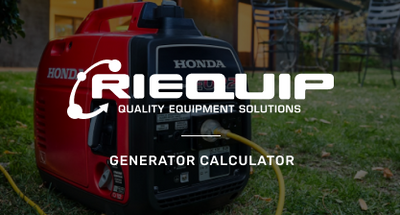
What is the best generator for house backup?
What is the best generator for house backup?
When the power goes out, a generator can keep your house warm in winter or cool in summer; it can keep your fridge and freezer cold, your kitchen cooking, and your laptops and phones charging.
People tend to buy generators around major storms and natural disasters, when they’re prone to making a rushed decision—without a plan for what to do when they get it home.
Generators are sold by power output, as measured in watts or kVA. The amount of power they deliver determines how many lights, tools and appliances you can run at once; the quality of that power determines how well they'll run. Figure on about 5,000 watts (6kVA) to cover the essentials in a typical home.
Start by making a list of what you don't want to go without while the power's down, then add up their watts to get a rough estimate of what you require.
The list below offers a guide on the wattages used on most common appliances and items used at home. For exact figures we recommend you check the nameplate or instruction manual for your individual items. You will also need to take into account the starting wattage or surge wattage. This is the amount of wattage required to start an appliance with an electric motor, such as a fridge, dishwasher or vacuum cleaner etc. This may be up to three times the wattage required to run the appliance, so this must be taken into consideration.
All generators also have a maximum and continuous wattage output. Maximum wattage is what the generator will be able to run for a short time such as when you start an electric motor.
Continuous wattage is the level where the generator can be operated at continuously.
Items below are continuous running watts
- Clothes Dryer 2000W
- Dishwasher 1200 - 3600W
- Electric Oven 2000W
- Heater 150 - 2000W
- Microwave 600 - 1500W
- Toaster 800 - 1500W
- Electric Frying Pan 1400W
- Iron 1000W
- Blow Hair Dryer 1000W
- Stove Range Hood 800W
- Coffee Maker 800-2000W
- Vacuum 1600-2000W
- Washing Machine 12000W
- Fridge/Freezer 300 - 700W
- Television 200 - 450W
- Computer + Monitor 100 - 400W
- Blender 350W
- Light Bulb 18 - 60W
- Laptop 50W
- Pump 1000W
Pick a Type
You can go one of four ways. Portable and inverter generators can both be moved around, though they come in different sizes. Diesel Standby Generators are installed permanently and kick on automatically during an outage. Solar backup generators are for houses that are fitted with a solar power system.
Portable Generators
- A portable generator consists of two main components, a gasoline or diesel-powered engine and an alternator. The alternator consists of a rotor (rotating) inside a stator (fixed). No matter what the load, a traditional style generator must run at full speed to provide the correct power of 50Hz.
- These units tend to cost less than inverter generators.
- They typically run on gasoline that you may need to store in large quantities. We recommend adding stabiliser to your fuel for prolonged storage.
- You can use portable generators anywhere on or off your property—but never in an enclosed space. These models can quickly produce deadly levels of carbon monoxide. Always run a portable generator at least 5m away from your home and direct the exhaust away from your home or any other structure.
- They typically provide power from 3,000 to 10,000 watts.
- View the Riequip range of Portable Generators Here.
Inverter Generators
- Inverter Generators are used where power is required for sensitive electronic equipment such as computers and sensitive electronics. They are also chosen when portability or size is important and where noise must be kept to a minimum.
- Because their engines are more complex, these models generally cost more than portable generators of a comparable output.
- Inverter generators are much quieter than their conventional counterparts because they throttle up and down to match demand rather than run at full power all the time. They also have more sophisticated exhaust systems which also help to reduce noise.
- They run more efficiently and produce fewer emissions. You should still follow all the same safety precautions you would with a portable generator.
- Inverter Generators typically range in size from 1,000 to 7,000 watts
- View the Riequip range of Inverter Generators Here.
Diesel Standby Generators
- These are commonly used on large houses, motels and commercial buildings etc
- They can be fitted with an Auto start-stop mains failure system. When the power goes off, the generator goes on—without you lifting a finger. This is great if you travel a lot or work far from home and can't always get there quickly in an emergency.
- The quality of power with this type of generator is generally the same as what you receive of the grid, so it is safe to run computers and sensitive electronic equipment.
- These generators will need to be installed by an electrician and bear in mind they weigh between 200-1000kg so you may need a Hiab truck for delivery
- View the Riequip range of Diesel Standby Generators Here.
Solar Backup Generators
- These are Generators designed for houses that have a solar power system. The generators are fitted with 2 wire auto start kits and are designed to connect directly to inverter battery chargers for charging deep cell batteries on solar systems.
- When the batteries get low because of cloudy weather etc the generator will automatically start and charge the batteries and then turn off when the batteries are fully charged.
- View the Riequip range of Solar Backup Generators Here.
Additional Features To Consider
Electric Start
- Some portable generators offer electric start, this is a great alternative to the hassle of pull-starting the engine. Verify that the battery is included with the generator. Bear in mind these can cost from $100 - $300 if not included.
Low-Oil Cut Out
- If oil falls below minimum levels, the generator shuts down to prevent engine damage. This is an important feature; always ensure the generator you are purchasing has this fitted.
Wheels
- A lot of generators have the option of wheels kits, if you are planning on moving your generator around your property this is a great add-on.
Outlet Sockets & Types
- Ensure your generator has standard NZ/AUS power outlet sockets, 15amp sockets are the most common size on generators sold in NZ.
- If you are planning on running your house from your generator you will need a generator with a 32amp outlet which will connect via a cable to your transfer switch.
What is a transfer switch?
- The short answer: It safely connects the generator to your circuit panel via one cable. Skipping it could endanger utility workers, cause appliances to fry, and damage the generator itself.
- You will need to organise an electrician to install the transfer switch.
Warranty & Backup Parts
- Just like your car, generators need servicing and sometimes repairs. Always make sure the generator you are buying has a comprehensive warranty and that all spare parts are available. Riequip has a nationwide network of service agents and guarantees spare parts backup.
Find out which generator is right for you
If you’re still unsure what generator you need to suit your requirements feel free to call us on 0800 378 478 or visit us one of our stores.


